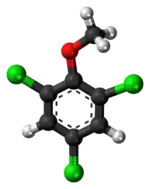 | |
 | |
| Names | |
|---|---|
| Preferred IUPAC name
1,3,5-Trichloro-2-methoxybenzene | |
| Other names
2,4,6-Trichloroanisole TCA 2,4,6-Trichloromethoxybenzene | |
| Identifiers | |
3D model (JSmol) |
|
| ChEBI | |
| ChemSpider | |
| ECHA InfoCard | 100.001.585 |
| EC Number |
|
| KEGG | |
PubChem CID |
|
| RTECS number |
|
| UNII | |
CompTox Dashboard (EPA) |
|
| |
| |
| Properties | |
| C7H5Cl3O | |
| Molar mass | 211.47 g·mol−1 |
| Melting point | 60 to 62 °C (140 to 144 °F; 333 to 335 K) |
| Boiling point | 140 °C (284 °F; 413 K) at 28 Torr |
| Hazards | |
| GHS labelling: | |
 | |
| Warning | |
| H302, H319, H413 | |
| P264, P270, P273, P280, P301+P312, P305+P351+P338, P330, P337+P313, P501 | |
Except where otherwise noted, data are given for materials in their standard state (at 25 °C [77 °F], 100 kPa).
Infobox references | |
2,4,6-Trichloroanisole (TCA) is a chemical compound that represents one of the strongest of off-flavors, substances "generated naturally in foods/beverages [that considerably] deteriorate the quality" of such products.[1][2] As of 2000, TCA was considered the primary chemical compound responsible for the phenomenon of cork taint in wines,[3][1] and it has an unpleasant earthy, musty and moldy smell.[2]
Chemically, TCA is a chlorinated derivative of anisole, and it is a formed by the biomethylation of 2,4,6-trichlorophenol.[4][5] More generally, it may be produced when naturally occurring airborne fungi and bacteria are presented with chlorinated phenolic compounds, which they then convert into chlorinated anisole derivatives.[6] Species implicated include those of the genera Aspergillus, Penicillium, Actinomycetes, Botrytis (e.g. Botrytis cinerea), Rhizobium, or Streptomyces.[7][8][6]
The chlorophenol precursor, 2,4,6-trichlorophenol, is used as a fungicide; more generally, related compounds can originate as contaminants found in some pesticides and wood preservatives, or as by-products of the chlorine bleaching process used to sterilize or bleach wood, paper, and other materials.[9]
TCA has also been suggested as cause of the "Rio defect" in coffees from Brazil and other parts of the world,[10] which refers to a taste described as "medicinal, phenolic, or iodine-like".[5] In investigation of the mechanism of its role in producing off-flavor effects, it was found to "attenuate olfactory transduction by suppressing cyclic nucleotide-gated channels, without evoking odorant responses."[1]
Further reading
- Marsili, R. (2000). "Solid-Phase Microextraction: Food Technology Applications". In Wilson, Ian D. (ed.). Encyclopedia of Separation Science. New Yor, NY: Academic Press. pp. 4178–4190. doi:10.1016/B0-12-226770-2/06791-0. ISBN 9780122267703.
Over the last two decades, the incidence of mouldy and musty off-flavours in cork-sealed wines has increased significantly. 2,4,6-Trichloroanisole (TCA) has been identified as the primary chemical responsible for cork taint. The human olfactometry threshold for TCA is 4–10 ng L−1 in white wine and 50 ng L−1 in red wine. In the case of wine, a worldwide loss of roughly US$1 billion per year is attributed to cork taint.
- Science Direct Staff (June 2023). "2-4-6-Trichloroanisole" (Science Direct citation sample/listing). Retrieved June 26, 2023.
- Buser, H.R.; Zanier, C. & Tanner, H. (1982). "Identification of 2,4,6-Trichloroanisole as a Potent Compound Causing Cork Taint in Wine". Journal of Agricultural and Food Chemistry. 30 (2): 359–362. doi:10.1021/jf00110a037.
{{cite journal}}: CS1 maint: multiple names: authors list (link) An early primary research report on the role of TCA in cork taint.
See also
References
- 1 2 3 Takeuchi, Hiroko; Kato, Hiroyuki & Kurahashi, Takashi (2013-09-16). "2,4,6-Trichloroanisole is a Potent Suppressor of Olfactory Signal Transduction". Proceedings of the National Academy of Sciences. 110 (40): 16235–16240. Bibcode:2013PNAS..11016235T. doi:10.1073/pnas.1300764110. ISSN 1091-6490. PMC 3791788. PMID 24043819.
{{cite journal}}: CS1 maint: multiple names: authors list (link) - 1 2 Jackson, Ron S. (2009). "Chapter 3: Olfactory Sensations". Wine tasting: a professional handbook. Food science and technology international series (2nd ed.). Academic Press. ISBN 978-0-12-374181-3.
- ↑ Marsili, R. (2000). "Solid-Phase Microextraction: Food Technology Applications". In Wilson, Ian D. (ed.). Encyclopedia of Separation Science. New Yor, NY: Academic Press. pp. 4178–4190. doi:10.1016/B0-12-226770-2/06791-0. ISBN 9780122267703.
Over the last two decades, the incidence of mouldy and musty off-flavours in cork-sealed wines has increased significantly. 2,4,6-Trichloroanisole (TCA) has been identified as the primary chemical responsible for cork taint. The human olfactometry threshold for TCA is 4–10 ng L−1 in white wine and 50 ng L−1 in red wine. In the case of wine, a worldwide loss of roughly US$1 billion per year is attributed to cork taint.
- ↑ Pereira, Helena (2007-01-01), Pereira, Helena (ed.), "Chapter 14 - Wine and cork", Cork, Amsterdam: Elsevier Science B.V., pp. 305–327, ISBN 978-0-444-52967-1, retrieved 2024-01-14
- 1 2 Spadone, Jean Claude; Takeoka, Gary & Liardon, Remy (1990). "Analytical Investigation of Rio Off-Flavor in Green Coffee". Journal of Agricultural and Food Chemistry. 38: 226–233. doi:10.1021/jf00091a050.
{{cite journal}}: CS1 maint: multiple names: authors list (link) Note, at best, this source states that 2,4,6-trichlorophenol is "the probable precursor of TCA". - 1 2 Cravero, Maria Carla; Bonello, Federica; Pazo Alvarez, Maria del Carmen; Tsolakis, Christos; Borsa, Daniela (24 June 2015). "The sensory evaluation of 2,4,6-trichloroanisole in wines: The sensory evaluation of 2,4,6-trichloroanisole in wines". Journal of the Institute of Brewing. 121 (3): 411–417. doi:10.1002/jib.230.
- ↑ Crane, Louise (22 March 2019). "Trichloroanisole: Cork taint". Chemistry World. Retrieved 2024-01-14.
- ↑ With regard to circumstantial evidence, Spodone, et al., op. cit., note that Rio off-flavor is associated with "beans heavily infested with various fungi (Aspergilli, Fusaria, Penicillia, Rhizopus, etc.) and bacteria (Lactobacilli, Streptrococci)".
- ↑ NTP (National Toxicology Program). 2021. "2,4,6-Trichlorophenol", Report on Carcinogens, Fifteenth Edition. Research Triangle Park, NC: U.S. Department of Health and Human Services, Public Health Service. https://ntp.niehs.nih.gov/go/roc15 DOI: https://doi.org/10.22427/NTP-OTHER-1003
- ↑ These include Central and South America.